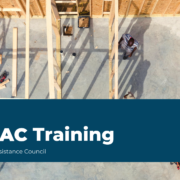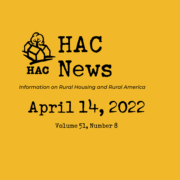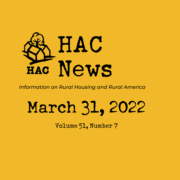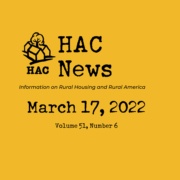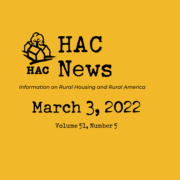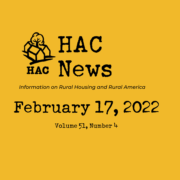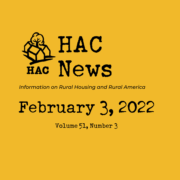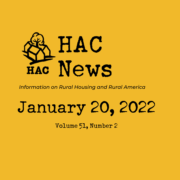Vol. 51, No. 4
TOP STORY
House passes funding extension, Senate action pending.
On February 8 the House adopted another continuing resolution to extend federal funding at fiscal year 2021 levels through March 11. The Senate is expected to approve the measure before the current CR expires at midnight on February 18. Congress hopes to use the added time to negotiate final appropriations for FY22, which began on October 1, 2021.
RuralSTAT
From 2020 to 2021, the number of sheltered people experiencing homelessness declined by 8% nationwide and by 6.5% in rural places. Source: HUD, 2021 Annual Homeless Assessment Report, Part I.
OPPORTUNITIES
Financial and technical assistance offered for CDFIs and Native CDFIs.
The CDFI Fund’s CDFI Program will make financial assistance and technical assistance awards to Community Development Financial Institutions. The Native Initiatives Program will make financial assistance or technical assistance awards to Native CDFIs. The deadline for all applications is April 12. For more information, contact the CDFI Fund Helpdesk, 202-653-0421, option 1.
Small grants available for community projects focused on age 50+.
The AARP Community Challenge provides small grants to nonprofits and government entities to fund quick-action projects that can help communities become more livable for people of all ages. This year, applications will be accepted for projects to improve housing, public spaces, transportation, and civic engagement; support diversity, equity, and inclusion; build engagement for programs under new federal laws; and pursue innovative ideas that support people age 50 or older. The deadline is March 22. For more information, contact AARP.
Community Innovations for Racial Equity to support health partnerships.
- The Community Innovations for Racial Equity Initiative of the Build Healthy Places Network invites applications by March 18 from community development corporations that are led by Black, Indigenous, or People of Color and are motivated to engage healthcare partners to advance racial equity. Selected organizations will receive funding, in-kind technical support, and facilitated connections to a national network of peer support. For more information, contact Colleen Flynn, BHPN.
- BHPN is also surveying BIPOC-led community development corporations about how they are engaging with the health sector to better support partnerships that advance racial equity. It hopes to identify needs relative to challenges and impacts emerging from the COVID-19 pandemic among these partnerships. The survey results will inform tools and capacity building resources for the field. The survey closes February 28.
Call on rural prosperity set for February 22.
HUD’s Rural Gateway will hold a Peer-to-Peer Web Conference Call on February 22 based on Investing in Rural Prosperity, a book recently published by the Federal Reserve Bank of St. Louis. Topics will include investing in climate resilience, supporting local entrepreneurship and small businesses, and advancing racial equity through rural development investments. For more information, call 1-877-RURAL-26 (1-877-787-2526).
Deadline for ReConnect broadband applications extended.
USDA will now accept applications through March 9 for the Rural eConnectivity (ReConnect) broadband deployment program. The agency may also increase the amount of funds available. For more information, contact Laurel Leverrier, USDA, 202-720-9554.
Corrections issued for RISE job accelerator program.
USDA has made corrections in its funding availability notice for the Rural Innovation Stronger Economy grant program. Applications are due April 19. For more information, contact Will Dodson, USDA, 202-720-1400.
Broadband assistance available, comments requested.
The 2021 infrastructure law created the Affordable Connectivity Program to help make broadband services and devices available to low-income households. ACP is based on the short-term Emergency Broadband Benefit Program and will replace EBB on March 1. For more information on transitioning from EBB to ACP, visit the FCC’s site or contact ACPinfo@fcc.gov. The Federal Communications Commission requests public comment by March 16 on the final rule it has adopted for the ACP and on proposals for increasing public participation as well as providing an enhanced benefit for consumers in high-cost areas. For more information on the regulations, contact Eric Wu, FCC, 202-418-7400.
Website helps claim Child Tax Credit and Earned Income Tax Credit.
Low-income families may be eligible to receive funds through the Child Tax Credit and Earned Income Tax Credit by filing a 2021 income tax return even if they would not otherwise have to file. Information and assistance on both credits is available at ChildTaxCredit.gov.
REGULATIONS AND FEDERAL AGENCIES
Rules for rural single-family housing programs revised.
- A final regulation for the Section 502 direct loan program and the Section 504 loan and grant programs adopts most of the changes proposed on November 25, 2019, with some modifications based on public comments. The changes include the use of loan refinancing to help borrowers who have difficulty keeping their accounts current (for example, after a payment moratorium). USDA will also have more flexibility in the future to revise the loan and grant caps for Section 504. For more information, contact Andrea Birmingham, USDA, 202-720-1489.
- Another final rule mandates use of the Guaranteed Underwriting System and the Lender Loan Closing System by approved lenders using the Section 502 guarantee program, effective May 9. For more information, contact Ticia Weare, USDA, 702-407-1400 x 6001.
USDA launches equity commission.
The members of USDA’s new Equity Commission and its Agriculture Subcommittee were announced on February 10. The body will provide recommendations on policies, programs, and actions to address equity issues within the Department and its programs. Its first virtual meeting, scheduled for February 28, will be open to the public. USDA’s press release states, “There are future plans to launch an additional Subcommittee focused on rural community and economic development.” For more information, email EquityCommission@usda.gov.
Civil rights office scrutinized.
USDA’s Inspector General reported recently that in 2017-2019 the department’s civil rights office continued to experience problems identified in past reviews. In 2019, the office averaged 799 days to process program complaints although its goal is to do so within 180 days. Complaints that may raise Fair Housing Act violations are referred to HUD but, in the three years covered by the study, HUD took an average of over 600 days to process complaints from USDA. At a February 15 House subcommittee hearing about the report, the IG said increased staffing and improved technology could help resolve the problems.
Wiggins nominated to head Delta Regional Authority.
Corey Wiggins has been nominated to serve as Federal Co-Chair of the Delta Regional Authority. The Delta Grassroots Caucus reports that Wiggins, currently the Executive Director of the Mississippi State Conference of the NAACP, is the first African American presidentially named to the DRA. The Senate has not yet begun to consider his nomination.
Housing regulator requests input on strategic plan.
The Federal Housing Finance Agency, which oversees Fannie Mae, Freddie Mac, and the Federal Home Loan Bank System, invites public comments by March 11 on its strategic plan for fiscal years 2022-2026.
Fannie Mae expands protections for rented sites in manufactured housing communities.
Fannie Mae has expanded its previous policy of encouraging Tenant Site Lease Protections for residents of manufactured housing communities. These protections are now required on all site leases, both owner-occupied and tenant-occupied, in communities with loans backed by Fannie Mae.
OneRD guaranteed loan platform regulation corrected.
USDA has issued a correction addressing omissions and errors in the December 10, 2021 final rule for the oneRD Guaranteed Loan Platform being used by several loan guarantee programs. For more information, contact Lauren Cusick, USDA, 202-720-1414.
PUBLICATIONS AND MEDIA
Annual report shows drop in sheltered homelessness, but data is incomplete.
HUD has released its Annual Homeless Assessment Report, presenting data collected in January 2021. The number of sheltered people experiencing homelessness declined by 8% nationwide from 2020 to 2021. The report suggests there may have been fewer shelter beds available because of pandemic guidelines, some people may have stayed out of shelters because of fears of illness, and policies like eviction moratoriums may have helped some people avoid homelessness. The report does not conclude whether overall or unsheltered homelessness numbers rose or fell because the pandemic prevented many communities from counting unsheltered people experiencing homelessness in 2021. Among the sheltered population, “largely rural” places accounted for 16.3% of total people experiencing homelessness, 16.6% of individuals, 15.9% of families, 20.7% of unaccompanied youth, and 17.6% of veterans.
FEMA program underserves rural counties, study finds.
Researchers from Texas A&M University examined how well the Hazard Mitigation Grant Program served urban and rural counties from 1989 to 2018. Their article, Naturally Resilient to Natural Hazards? Urban-Rural Disparities in Hazard Mitigation Grant Program Assistance, published in Housing Policy Debate, identifies “vast inequities in the distribution and duration of HMGP assistance” and concludes that “the current structure of the HMGP leaves rural counties in the dust.”
New index shows where rural capacity is limited.
Headwaters Economics has created a Rural Capacity Index based on 10 variables intended to function as proxies for community capacity. The variables incorporate metrics related to local government staffing, community education and engagement, and socioeconomic trends. An interactive map presents results at the county, county subdivision, and community levels. Headwaters suggests the index can be used by communities to advocate for resources and by federal and state agencies to target investments.
Experts say better capacity building and more funding needed for Indian Country housing.
A recent article on HAC’s website, Self-Determination in Tribal Housing: Reflections on NAHASDA’s Impact, reports the views of four experts on housing in Indian Country regarding the Native American Housing Assistance and Self-Determination Act. One of HAC’s 2022 Rural Housing Policy Priorities is the reauthorization of NAHASDA with targeted improvements to build on its 25 years of achievements.
Disaster planning ensures community resilience and vitality.
The Conversation reports that vulnerable residents, who live in lower quality affordable housing located in less desirable locations, are most affected by disasters and least able to recover from them, slowing down recovery for the community as a whole. Disasters Can Wipe Out Affordable Housing for Years Unless Communities Plan Ahead – The Loss Hurts the Entire Local Economy points out that in some rural areas, replacement values are not enough to rebuild equivalent housing, so homes go unbuilt. Community land trusts, relaxed rental rules, and monitoring recovery funds offer relief.
Total value of U.S. homes hits record high in 2021.
Redfin reports that from 2020 to 2021, the total value of U.S. homes increased 18.6%, approximately $6 trillion, for a record high of $38.6 trillion in December 2021. The total value of rural homes increased by 19.5%, resulting in a total of $4.2 trillion. Benefits of increasing home values were seen in rural places and metropolitan areas. The wealth increase for homeowners widened the gap between renters and homeowners across the U.S., however.
3G shutdowns problematic in rural places.
Rural America May Experience Service Blackouts as Providers Sunset 3G Service, a Daily Yonder article, looks at the impact of mobile carriers shutting down older 3G service to make room for newer technology. Some advocates for survivors of domestic violence expressed concerns whether there has been sufficient coverage about the potential loss of service for those with older phones, especially “people in rural areas, those living on reservations, people who are low-income, and people of color.”
HAC
NEW! HAC seeks Policy Director, Community Development Specialist, Loan Processor Associate, and Housing Specialist.
- The Director of Policy is a newly created position based in HAC’s Washington DC headquarters, reporting directly to the CEO and serving on HAC’s Executive Leadership Team. This individual will be expected to maintain HAC’s position as the leading authority on current rural housing and community development policy; grow HAC’s role as a non-partisan, evidence-driven authority trusted by policymakers and practitioners; and represent HAC in a wide range of forums, demonstrating issue mastery and thought leadership when communicating with Congress, federal agencies, the affordable housing and community development industry, the media, and the general public. Some travel is required.
- The Community Development Specialist works with nonprofits and local governments on all facets of developing community resources such as parks, community centers, public libraries, childcare centers, health care facilities, or other public spaces. Requirements include four years of relevant work experience. This position is eligible for telecommuting.
- The Loan Processor Associate is an entry-level position and will assist in managing HAC’s portfolio of loans made to entities engaged in affordable housing activities throughout the rural U.S.
- The Housing Specialist is primarily based in either the Southwest or Western states and works with local partner organizations to support the preservation and development of affordable housing and community and economic development strategies.
Need capital for your affordable housing project?
HAC’s loan fund provides low interest rate loans to support single- and multifamily affordable housing projects for low-income rural residents throughout the U.S. and territories. Capital is available for all types of affordable and mixed-income housing projects, including preservation, new development, farmworker, senior and veteran housing. HAC loan funds can be used for pre-development, site acquisition, site development, construction/rehabilitation and permanent financing. Contact HAC’s loan fund staff at hacloanfund@ruralhome.org, 202-842-8600.
Please note: HAC is not able to offer loans to individuals or families. Borrowers must be nonprofit or for-profit organizations or government entities (including tribes).

